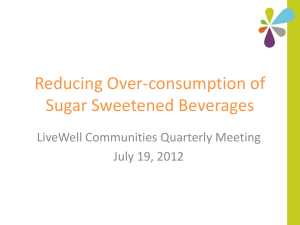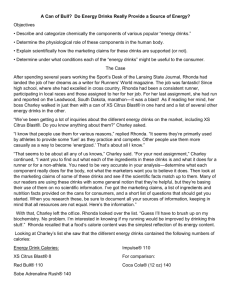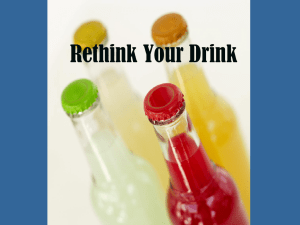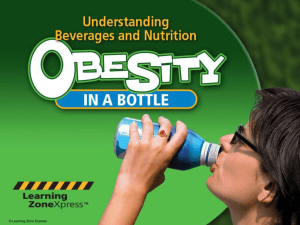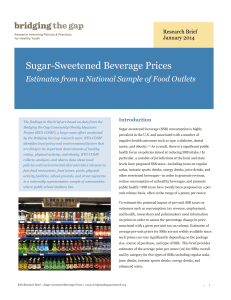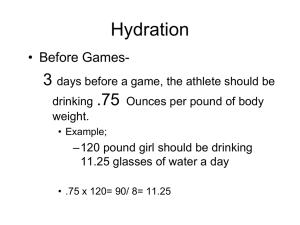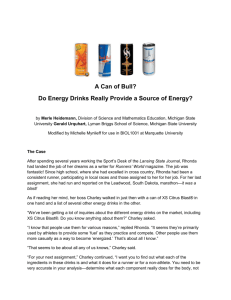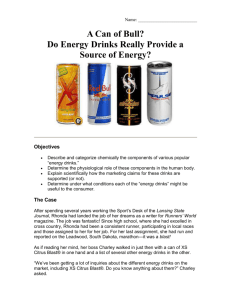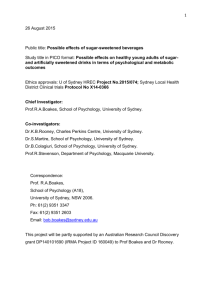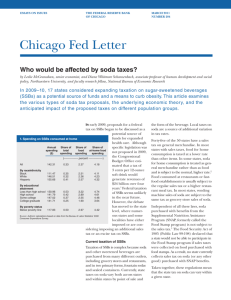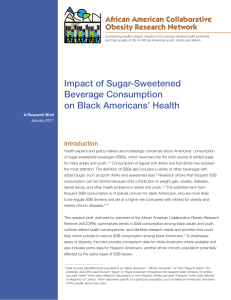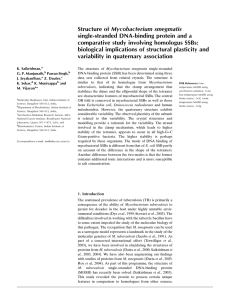health literacy - Camden Coalition of Healthcare Providers
advertisement
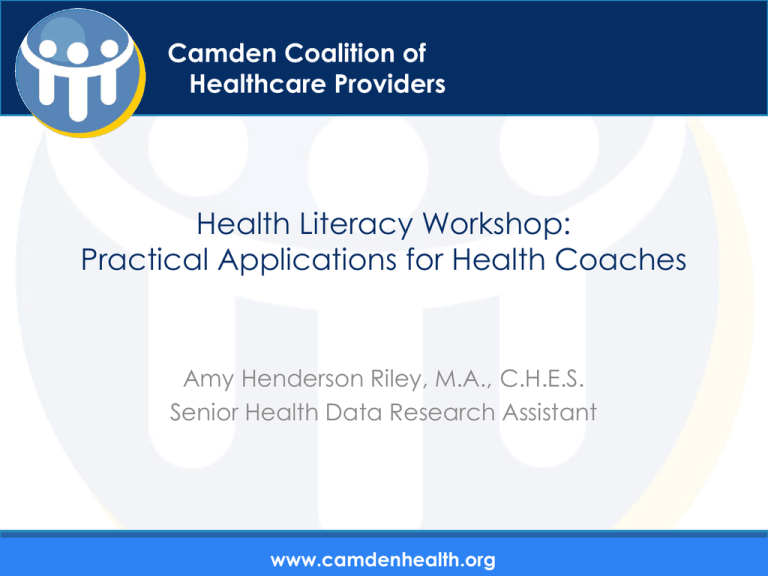
Camden Coalition of Camden Coalition of Healthcare Providers Healthcare Providers Health Literacy Workshop: Practical Applications for Health Coaches Amy Henderson Riley, M.A., C.H.E.S. Senior Health Data Research Assistant www.camdenhealth.org Objectives • • • • • Introductions What is health literacy? Why is health literacy important? How can we apply these concepts? Q&A About Me: •Research Assistant @ CCHP for Hotspotting Toolkit •Master’s in Health Education (Columbia University) •Certified Health Education Specialist (CHES) Previous employment: •NYC Dept. of Health •US Dept. of Health and Human Services •Ghana Health and Education Initiative (NGO) GHEI Handwashing Program SUGAR-SWEETENED BEVERAGES SUGAR-SWEETENED BEVERAGES (SSBs) IT’S NOT YOUR FAULT SSBs are beverages containing sweeteners that are added during processing such as non-diet sodas, sports drinks, energy drinks, fruit drinks, powdered drinks, and flavored drinks.1 Sugar Sweetened Beverages are Everywhere A recent study found that 95% of drug stores sell junk food.11 The availability of fresh and healthy foods is decreasing.12 The Sugar You May Be Drinking2 LEARN TO READ NUTRITION LABELS (ex. Soda)13 Start at the top of the label. There are often multiple servings in one container. Scan the label to estimate number of calories in the entire package. A 12 oz Soda Can may contain 10 teaspoons of sugar A 20 oz Soda Bottle may contain 17 teaspoons of sugar Sweeteners Come By Many Names Brown sugar Corn Sweetener Corn Syrup Dextrose Fruit juice concentrates Glucose High-fructose corn syrup Honey Invert sugar 3 Lactose Maltose Malt syrup Molasses Raw sugar Sucrose Sugar Syrup SSB FACTS American adults now drink 190 calories per day from SSBs. Children ages 6-19 consume 300 calories per day from SSBs, most of which are consumed in the home.4 SSBs in NYC In low-income neighborhoods, 15% of adults drink 2 or more SSBs per day and 44% drink 1 or more SSBs compared with other neighborhoods.5 Individuals in these neighborhoods are also more likely to be affected by heart disease, cancer, diabetes, obesity and overweight, and are more likely to die younger.6 Excess Calories Unused calories may lead to weight gain. Two thirds of adults and one third of children are now overweight or obese.7 Health Costs SSBs are linked with weight gain and obesity. Drinking 1 SSB a day for a year could cost you over $400 and could cause you to gain 10 pounds.8 Other health problems include diabetes, anxiety, withdrawal, poor-quality or reduced sleep, and tooth decay.9 Financial Costs Obesity costs $1,723 a year per person.10 This affects everyone indirectly with increased health care spending. By reducing your SSB intake could directly save your family hundreds of dollars. Look for the “Sugar” line under “Carbohydrates.” This will tell you if the product is an SSB. Confirm this by searching for sweeteners in the ingredients list. Ingredients are listed in descending order of weight (most to least). 7 STEPS FOR HEALTHY HYDRATION14 1. Drink Plenty of Water It’s the best thirst quencher without sugars or calories. NYC Tap Water is considered the nation’s safest and freshest! Take advantage of our free and delicious water by carrying a reusable container. Try seltzer if you want fizz. Add a splash of fresh lemon or lime for flavor. Discover the health benefits of herbal teas. 2. Choose Fat-Free or 1% Milk It’s packed with nutrients with fewer calories and less fat. Almost everyone over age 2 should drink fat-free or 1% instead of whole milk. Try low-fat soymilk in light or unflavored. 3. Switch from Juice to Whole Fruit (100% juice) Fruit juice is full of calories. Whole fruit has fewer calories and has fiber, which helps keep you healthy and feel full. 4. Skip Sports Drinks and “Energy” Drinks Sports drinks are high in caffeine and low in nutrients. Energy drinks are the same but also full of caffeine. 5. Watch Out for Coffee, Tea Drinks, and Shakes Many of these popular drinks are full of calories. 6. Downsize! If you do have a SSB, order it in small” instead of “large.” Add seltzer or water to juice to cut calories and make it last longer. 7. Be a Healthy Role Model for Your Family’s Well-Being Inspire your loved ones to lead healthy lives. • NYC Dept of Health “one pager” • Can you understand this document? • Do you think your patients could understand this document? 2-minute Intro video • Poem from a Mental Health conference • http://www.youtube.com/watch?v=R 3tJ-MXqPmk What is Health Literacy? Definition: “the degree to which individuals have the capacity to obtain, process, and understand basic health information and services needed to make appropriate health decisions” - Healthy People 2020 Literacy Across Health Interactions • Written materials: - Brochures - Forms - Prescription labels - Signs • Oral instructions: - Doctors, nurses, health coaches Why is health literacy important? CCHP patients: •Multiple chronic diseases •Multiple prescriptions •Older population, difficulties with activities of daily living/limited physical activity •Socio-economic status •Education-level, reading level •Learning disabilities •Mental illness •Chronic Pain •Low self-efficacy •English as a second language (or 3rd…) Where do we begin? • Start with respect/meet patients where they are (what does this mean in terms health literacy?) Concepts of Adult Learning • Adult learners are the experts on themselves. • Adult learners have vast experiences that we can use to implement tailored messages. • Adult learners know how they learn best. Application #1: Plain Language • Plain language is using clear writing without unnecessary words or explanations • Plain language is not “dumbing down” messages Characteristics of Plain Language • Active voice (ex: “We called your doctor,” instead of, “The physician’s office was called.” • Less than a dozen words per sentence • No words over 3 syllables • 30% white space • Same concepts for Spanish documents Exercise: Assess Plain Language • - Review a CCHP document for: Active vs. passive voice Number of words per sentence Number of syllables per word White space Exercise: Assess Reading Level • SMOG (Simple Measure of Gobbledygook) Readability Index • Review a document -- How many words with more than 3 syllables in 30 sentences? Application #2: Use More Visuals • • • • • Culturally respectful materials Be careful of colors Use more Visuals Visuals include touch Pictures on your contact information Exercise: Add Visuals • Review a CCHP document for: - Count number of pictures or diagrams Are the pictures simple to understand? Is there a clear background with no text? Are there areas where a picture or diagram could be included? - Is there an area to be “filled in” either by health coach or patient? - Is the material culturally appropriate? - How can you “guide” this document for the patient”? Application #3: Teach Back • “Please tell me in your own words what I have just said/explained to you.” • Example: Teaching a patient about their prescriptions by filling one pill day in the container (i.e. Monday) and letting the patient fill the rest of the week Exercise: Incorporate Teach Back Technique • Brainstorm 3 ways you can incorporate “teach back” with your patients • Share with the group Application #4: Active Listening • • • • • • Being silent Ask open-ended questions Paraphrase – is that right? Empathizing Supporting Motivational Interviewing Techniques Exercise: Practice Active Listening • Write down one way you can incorporate active listening into your patient interactions and how this affects health literacy Additional Information • CDC Health Literacy: http://www.cdc.gov/healthliteracy/ • HRSA Health Literacy: http://www.hrsa.gov/publichealth/healthliteracy/ • Harvard Health Literacy Studies https://www.hsph.harvard.edu/healthliteracy/ Q&A THANK YOU amy@camdenhealth.org
